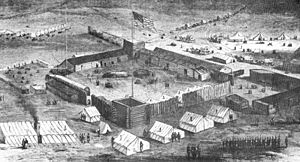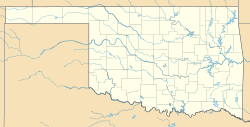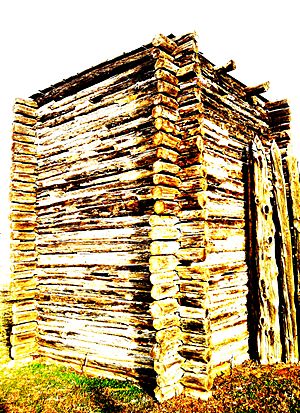Fort Supply (Oklahoma) facts for kids
Quick facts for kids Fort Supply |
|
|---|---|
| Indian Territory / Woodward County, Oklahoma, USA (near Fort Supply, Oklahoma) |
|

Camp Supply Stockade, Harper's Weekly, February 1869.
|
|
| Type | Fort |
| Site information | |
| Controlled by | United States |
| Site history | |
| Built | 1868 |
| In use | 1868–1895 |
| Materials | Logs & stone |
| Battles/wars | Indian Wars on the Southern Plains |
|
Fort Supply Historic District
|
|
| Location | Western State Hospital grounds, Fort Supply, Oklahoma |
| Area | 5 acres (2.0 ha) |
| Built | 1893 |
| NRHP reference No. | 71000675 |
| Added to NRHP | June 21, 1971 |
Fort Supply was an important United States Army post. It was first called Camp Supply. Soldiers built it on November 18, 1868, in what was then Indian Territory. The fort's main job was to protect the southern Plains region. It was located just east of where Fort Supply, Oklahoma is today.
Contents
History of Fort Supply
How Camp Supply Started
Fort Supply began as "Camp of Supply" in November 1868. It supported General Philip Sheridan's winter campaign. This campaign was against the Southern Plains Indians tribes. From Camp Supply, George Armstrong Custer led his soldiers. They went south to the Washita River. There, they attacked the village of Cheyenne chief Black Kettle. This event is known as the Battle of the Washita.
Protecting Native American Lands
Later, the camp helped protect the Cheyenne and Arapaho reservations. These lands were managed by the Darlington Agency. The fort kept white settlers from entering these protected areas. In 1878, the camp was renamed Fort Supply. This happened after its role in the Red River War from 1874 to 1875.
The Fort's Later Years
By 1880, the conflicts with Native American tribes on the Southern Plains were mostly over. The fort was in poor condition. Army officers suggested closing it. But Philip Sheridan, who was then General of the Army, disagreed. He worked to create the Fort Supply Military Reservation. This made the fort and its surrounding 36 square miles a permanent area.
Fort Supply Closes
Fort Supply officially closed in September 1894. This was after the Cherokee Outlet opened for settlement. One of the last jobs for troops from Fort Supply was ending the Enid-Pond Creek Railroad War. This conflict involved people destroying train tracks in the summer of 1894. On February 26, 1895, the last soldiers left. They handed over the old fort to the Department of the Interior.
What Happened to the Site After the Army Left?
In 1908, Oklahoma's first hospital for mental health was built at the old post. Today, it is called the Western State Psychiatric Center. In 1988, the state government named the remaining buildings the Fort Supply Historic District. Soon after, the William S. Key Correctional Center opened at the site. The Fort Supply Historic District was added to the National Register of Historic Places in 1971.
Fort Supply Historic Site Today
The Oklahoma Historical Society now runs a visitor center at Fort Supply. They are working to restore five of the original buildings. The visitor center has exhibits about the fort's history. It also shares stories about northwest Oklahoma.
Restored Buildings and Replicas
The buildings being restored look just like they did long ago. They include:
- The 1874 Ordnance Sergeant's Quarters
- The 1882 Civilian Employee Quarters
- The 1878 Commanding Officer's Quarters
- The 1882 Officers' Quarters (a duplex)
- The 1892 Guard House
The Guard House has exhibits with old tools and photographs.
The site also has copies of old structures. These include a replica of the 1869 stockade. There is also an army supply wagon, a mountain howitzer (a type of cannon), and a Cheyenne tipi.




